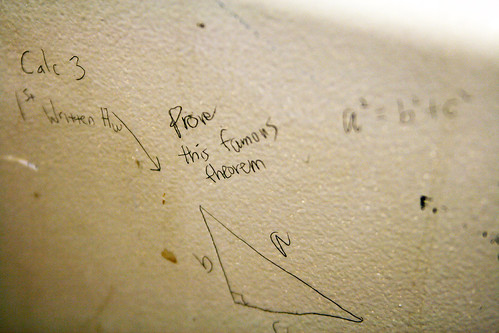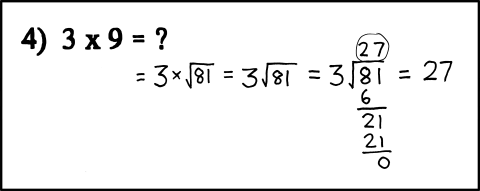
Editorial
The Carnival of Mathematics #66 was hosted at Wild About Math! This is Carnival of Mathematics #67.
If you’re new to the Carnival of Mathematics, check out Mike Croucher’s introduction at Walking Randomly.
 Photo by woody1778a.
Photo by woody1778a.My first task is to choose an interesting fact about the number of the carnival. Well, the excellent Number Gossip tells me as well as being Odd, Prime, Square-free, Lucky, Odious, Deficient and a Lazy caterer, 67 is the largest prime which is not the sum of distinct squares, which seems interesting. Just to demonstrate the level of trivia in the world of numbers, here are some other contenders:
- 67 is the smallest number which is palindromic in bases 5 and 6 (What’s Special About This Number?);
- 67 is the only number such that the common alphabetical value of its Roman representation is equal to its reversal (LXVII – 12+24+22+9+9=76) (Number Gossip);
- 67 is the sum of five consecutive primes (exercise for the reader to work out which) (Wikipedia);
- 67 is the smallest prime which contains all ten digits when raised to the tenth power (Number Gossip).
Right, on with the Carnival…
Headlines
Since I’ve started a ‘news’ theme, we’d better have some headlines.
Over at AMS Math in the Media, Allyn Jackson edits a collection of Summaries of Media Coverage of Math for June 2010.
It is worth taking a look at the MAA’s Math in the News archive for recent maths news.
The next Carnival of Mathematics host, Plus Magazine, have published their issue 55.
My own interest in mathematics news and maths in the media is fuelled by my role as the “maths” half of the new Math/Maths Podcast, a weekly conversation about mathematics between the UK and USA.
Culture
 At the Make: Online blog, George Hart, for the Museum of Mathematics, writes a Math Monday article on Mathematical beading. This includes the image above – can you tell what it is? Go to the article to find out. George gives five examples by Bih-Yaw Jin, and asks What interesting shapes can you make with beads?
At the Make: Online blog, George Hart, for the Museum of Mathematics, writes a Math Monday article on Mathematical beading. This includes the image above – can you tell what it is? Go to the article to find out. George gives five examples by Bih-Yaw Jin, and asks What interesting shapes can you make with beads?
At General Musings, Daniel Colquitt considers the Sierpiński Triangle in Nothing inside infinity, giving an interesting roundup as part of a series of articles he has written on objects which are infinite in some dimensions but finite in others.

Edmund Harriss of Maxwell’s Demon has been playing with spreading text over tilings and gives some examples based on some of his favourite typefaces in Tiling Typography. The example above is a Penrose Tiling based on Garamond.
Alexander Bogomolny of CTK Insights writes A curious variant of the Pythagorean theorem, in which he gives a symmetric form of the Pythagorean theorem in which no one angle is being paid special attention.
 Photo by quinn.anya.
Photo by quinn.anya.Education
Joel Feinstein of Explaining Mathematics has been screencasting his lectures (read his case study), but recently has been struggling with the question of whether students really benefit from his doing this; so he asks: Should we make videos of our lectures available?
Tom DeRosa of I Want to Teach Forever writes a provocative post Why We Fail at Teaching the Language of Data, in which he gives his opinion on the emphasis placed on data analysis at school level and argues more time should be spent learning to look critically at data.
Design
 Picture by wburris.
Picture by wburris.In The design of mathematical notation at The Number Warrior, Jason Dyer considers mathematical notation as a design issue and gives a series of examples of design that hinders, rather than aides, understanding.
On the subject of poorly designed notation, don’t get Murray Bourne of squareCircleZ started on the notation for natural logarithm! In Logarithms – a visual introduction, he motivates logarithms from a historical perspective, and uses an example to show how logarithms are useful and how they are used.
Gadgets
 Photo by Extra Ketchup.
Photo by Extra Ketchup.Recently I hosted a seminar by Birgit Loch at the University of Nottingham and played with her new iPad, stuffed full with every free mathematics app in the Store. There was some interesting stuff there, so I am pleased to see Mike Croucher has started a new series of articles on Walking Randomly to explore the options for doing mathematics on this new platform. Start with Math on iPad #1. Meanwhile, David Warlick writes at 2¢ Worth with a roundup of tools for taking mindmap notes in Taking Notes on the iPad.
Computers and technology
Fëanor writes to say that at bit-player is Disentangling Gaussians, in which Brian Hayes writes about how ideas going back to the 1890s have been used recently to provide a computational (polynomial time) solution to a statistical question answered, to a mathematician’s satisfaction, in the 1950s and 60s.
 Photo by Nat W.
Photo by Nat W.John D. Cook at The Endeavour writes Math library functions that seem unnecessary, in which he gives examples of functions in the standard C math library that seem unnecessary at first glance, and the special cases that make them indispensable.
Fredrik Johansson posted Incomplete elliptic integrals complete, in which he describes his implementation of the arbitrary precision calculation of incomplete elliptic integrals in the free, open source mathematical software mpmath.
Katie O’Hare of NAG writes with a post by Mick Pont to The NAG Blog, which asks Why is writing good numerical software so hard? Mick discusses the reasons why software development is still needed.
At the Wolfram Blog, Ed Pegg Jr writes in The Circles of Descartes with a description of the Descartes Circle Theorem and an implementation in Mathematica.
Review
 “Shecky Riemann” of Math-Frolic! writes with The Savant Mind At Work, a book review of “Embracing the Wide Sky” by autistic savant & “math whiz” Daniel Tammet.
“Shecky Riemann” of Math-Frolic! writes with The Savant Mind At Work, a book review of “Embracing the Wide Sky” by autistic savant & “math whiz” Daniel Tammet.
Puzzles
James Grime writes with a classic puzzle he recently featured on his YouTube channel: Two Trains One Fly. This YouTube video is below and the solution can be found in Two Trains One Fly Solution.
Meanwhile, over at Mind Your Decisions, Presh Talwalkar discusses solutions for another of James’ YouTube puzzles in Salem witches – a math puzzle.
Cartoon
Sport
 Photo by CLF.
Photo by CLF.The Plus blog has a roundup of World Cup maths stories, for those who are that way inclined, while Tim Gowers is musing on a year of tennis in A mathematician watches tennis II.
And finally…
To end on a bit of fun, like all quality news reports, during a recording of the Math/Maths Podcast, Samuel Hansen showed me a couple of spoofs from David Simmons-Duffin: In arXiv vs. snarXiv, the game is to say which of two article titles is from the real arXiv, a “highly-automated electronic archive and distribution server for research articles”, and which is from the spoof snarXiv, a “random high-energy theory paper generator incorporating all the latest trends, entropic reasoning, and exciting moduli spaces”. Meanwhile, the Theorem of the Day generator is cooking up realistic looking ‘theorems’ and ‘proofs’ using a context free grammar.
Here ends Carnival #67. If you liked it, the sister carnival Math Teachers at Play #27 has been posted at Ramblings of a Math Mom. Carnival of Mathematics #68 will be hosted at Plus on 6th August. Please submit your articles via the carnival submission form.

Lotta nice variety here! looking forward to working my way through much of it.
Excellent tips and links. Thanks.
So many interesting articles and ideas, fascinating stuff!
Thanks. Lot’s of good stuff to read.